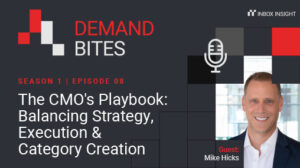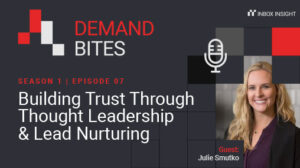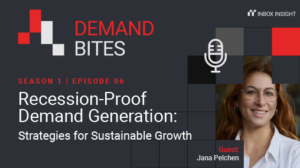Picture the last deal that got stuck in your pipeline. Maybe it dragged on for months, or perhaps it’s still sitting there now, neither moving forward nor falling away.
You’re not alone – the typical B2B sales cycle stretches over 2.1 months, tying up resources and delaying revenue. But by rethinking your demand generation strategy, you can help prospects move more naturally toward purchase decisions while building stronger relationships along the way.
The power of strategic demand generation
Effective demand generation does more than just create awareness – it prepares prospects for quicker decisions by engaging them meaningfully early in their buying journey. When marketing and sales teams work in lockstep, sharing insights and coordinating their approach, the entire process becomes more efficient. Tools like CRM systems and analytics platforms help track progress through each stage, from initial contact to closed deal, revealing opportunities to remove friction from the buyer’s journey.
Different customers move at different speeds. Enterprise deals typically take longer due to multiple stakeholders and higher stakes, while smaller businesses often make faster decisions. Understanding these patterns helps you set realistic expectations and adapt your approach accordingly. Rather than pushing everyone through the same process, you can create tailored pathways that respect each customer’s natural buying rhythm while gently accelerating their progress.
Common roadblocks and their solutions
Several challenges typically slow down sales cycles:
- Misalignment between marketing and sales teams creates confusion and mixed messages. The solution is establishing shared goals and regular communication channels that keep everyone synchronized.
- Poor lead qualification wastes time on prospects who aren’t ready to buy. By improving qualification criteria and implementing proper scoring systems, you can focus resources on the most promising opportunities.
- Generic marketing messages fail to resonate with specific customer needs. Personalized campaigns and content that speak directly to each prospect’s challenges help accelerate decision-making by demonstrating clear value.
The benefits of a faster sales cycle
When you successfully shorten your sales cycle, the benefits multiply. Beyond the obvious advantage of faster revenue generation, your team can handle more opportunities with the same resources. Customers benefit too – they receive more relevant information and support throughout their journey, leading to better buying experiences and stronger long-term relationships.
Most importantly, a well-optimized sales cycle doesn’t feel rushed to the customer. Instead, it feels like a natural progression where they receive exactly what they need at each step to make confident decisions at their own pace.
Your framework for faster sales cycles
Step 1: Develop hyper-targeted buyer personas
Success in shortening your sales cycle starts with understanding exactly who you’re selling to. By developing detailed buyer personas that capture not just demographics but real challenges and motivations, you can focus your efforts on the prospects most likely to convert. This understanding should evolve continuously based on feedback and results, ensuring your approach stays relevant as market needs change.
Step 2: Optimize your lead qualification process
With clear personas in place, you need a robust system for qualifying and prioritizing leads. Lead scoring is a valuable tool in this process, helping assess lead quality based on factors like engagement levels, persona fit, and purchase readiness. However, it’s more than just a scoring system – it’s a way to align your marketing and sales teams on what constitutes a qualified lead.
This alignment ensures consistency in lead evaluation and bridges the gap between Marketing Qualified Leads (MQLs) and Sales Qualified Leads (SQLs). The result is often a more efficient process, with improved collaboration between teams and a focus on the most promising opportunities. This can lead to higher conversion rates and a shorter overall sales cycle.
Step 3: Create your content engine
The key to faster sales cycles lies in delivering the right content to the right person at the right time. 91% of B2B buyers expect at least some level of personalization during the purchasing process, so it’s important to create content that speaks directly to your prospects’ unique challenges and goals. From thought leadership pieces to solution guides, each piece of content should move prospects closer to a buying decision by building trust and demonstrating clear value.
Step 4: Leverage marketing automation
Marketing automation is the key to scalable, personalized outreach. Implement smart nurture tracks that adapt based on prospect behavior, engagement, and intent data. This ensures prospects receive relevant information tailored to their specific journey. For example, if a prospect downloads a technical whitepaper, automatically follow up with an invitation to a related demo.
The goal isn’t to automate everything, but to create a responsive system that supports your team’s efforts to build genuine relationships with prospects. By balancing automated touches with personal outreach from your sales team, you can handle routine tasks efficiently while freeing up time for meaningful interactions.
Step 5: Empower your sales team
To convert leads effectively, equip your sales team with the right tools and resources. Develop a comprehensive sales enablement program featuring product demos, presentation templates, and objection-handling guides. These resources can empower your team to respond swiftly and confidently to any situation they encounter, turning potential roadblocks into opportunities.
The key is ensuring these resources aren’t just created and forgotten. Regular updates based on field feedback and win/loss analysis help keep your sales enablement materials relevant and effective. Establish clear processes for sharing successful approaches across the team, turning individual wins into repeatable practices everyone can benefit from.
Step 6: Build trust through social proof
Nothing accelerates decision-making quite like seeing how others have succeeded with your solution. Create a systematic approach to collecting and sharing customer success stories, focusing on specific outcomes and challenges overcome. The most effective case studies speak directly to different buyer personas, addressing their unique concerns and situations.
But social proof goes beyond formal case studies. Train your team to naturally weave customer stories into their conversations, and create easy-to-share content snippets featuring customer quotes and wins. This helps prospects see themselves in your success stories, making it easier for them to move forward with confidence.
Step 7: Perfect your timing with intent data
Intent data is a powerful tool that identifies prospects actively researching products or services in your industry, providing actionable insights into their buying journey. Think of it as your early warning system – it tells you when prospects are ready to engage, allowing you to focus resources on those who are actually prepared to buy.
By integrating intent data into your lead scoring model, you can:
- Prioritize high-intent prospects: Focus on leads showing strong buying signals, ensuring your time and resources are directed where they’ll have the most impact.
- Enhance personalization: Craft messages that speak directly to what prospects are currently researching and considering. This hyper-personalized approach improves engagement and accelerates decision-making.
- Streamline marketing-sales collaboration: Share intent data across teams to align strategies and synchronize outreach efforts. This reduces friction in the handoff process and ensures a seamless experience for the prospect.
- Shorten the decision-making process: By engaging prospects who are actively researching solutions, you can address their pain points quickly and effectively, eliminating the wasteful delays of cold outreach.
Step 8: Measure and optimize continuously
Success in reducing your sales cycle requires constant refinement based on real data. Implement robust attribution models to track both leading indicators (like engagement rates and intent signals) and lagging indicators (like conversion times and deal sizes). This holistic view helps you understand the effectiveness of your demand generation campaigns and spot opportunities for improvement early.
Pay special attention to where prospects tend to slow down or drop off in your process. Use this information to adjust your content strategy, refine your lead scoring model, or improve team coordination – whatever the data suggests will have the biggest impact.
Final thoughts
Transforming your sales cycle isn’t about finding a magic shortcut – it’s about building a smarter, more responsive system that serves both your team and your customers better.
When you combine detailed buyer understanding with strategic content, automate the right processes while keeping the human touch, and use data to guide your decisions, you create an environment where deals can progress naturally and efficiently.
Your prospects get the information they need when they need it, your team spends time on the most promising opportunities, and everyone benefits from a more streamlined journey – from first touch to closed deal.






